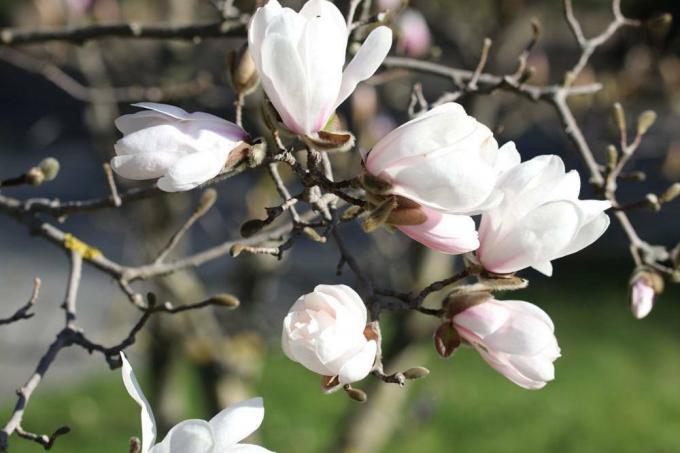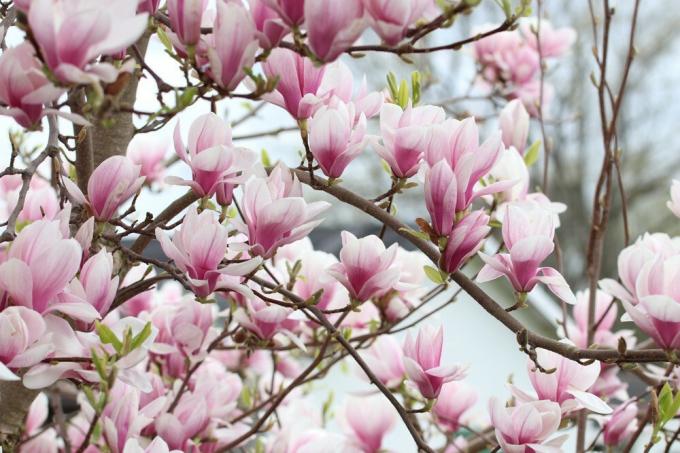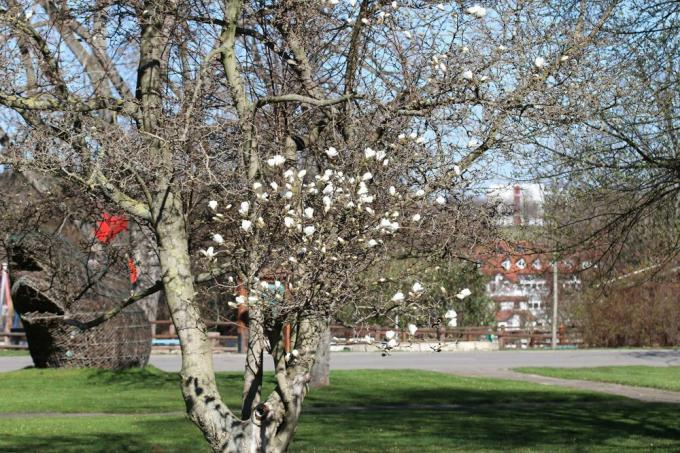
table of contents
- Pruning magnolia tree
- Reasons to cut back
- time
- No annual cut
- Sharp cutting tool
- Maintain natural habit
- Radical cut only in an extreme emergency
- Construction cut after planting
- Magnolias as a standard trunk
- Is it necessary to cut back?
Magnolias are compact and have a beautiful, dense crown. At times they can also form shoots with bizarre growth. Depending on the variety, magnolia trees reach a stately height and width with age. Sometimes corrective cutting is then necessary. A pruning is then entirely possible and not particularly difficult. However, a few things should be taken into account so that the beautiful natural growth shape is maintained and the tree is not damaged.
Pruning magnolia tree
Reasons to cut back
Magnolias are usually quite firm. However, problems with wound healing can occur when pruning, which in turn can lead to pathogens penetrating quickly. Actually, magnolias, such as the witch hazel or various types of snowball, ideally do not necessarily have to be cut back. However, there are sometimes reasons where a corrective cut is appropriate, such as:
- Tree has become too tall and too wide
- Lack of space, impairment of buildings, lack of light, etc.
- after storm or other weather damage
- in case of illness
- to quickly increase the number of flowers
- Construction cut directly after planting
time
As with all other flowering trees, pruning, if at all, right after flowering to be done. At this point, the plants are fully in sap and foliage. Wounds caused by the cut then close quickly so that pathogens such as spores and fungi have no way of penetrating the wood. The best time is
- the early summer immediately after flowering
- depending on the variety from the end of May to the beginning of July, late bloomer to late summer
- in autumn only in an emergency after damage
A pruning in early spring before flowering should be avoided in any case, because frost damage can still occur. Usually the magnolias then have a very difficult time recovering. Autumn is also not favorable, as the plants here can hardly cope with pruning and cut wounds do not close for a long time. Furthermore, there may be no flower formation in the following year.
No annual cut
Magnolias are very slow growing. The abundance of flowers increases steadily into old age. The reason for this is their acrotonic growth. Here, new shoots form from the end and upper side buds of the branches, which at the same time leads to an even crown structure with strong branches in the outer crown area. After four to five years, an optimal flower set is usually achieved and then quickly becomes obsolete. In principle, therefore, everyone should three to five years a Taper cut take place, which ensures a new splendor of flowers. However, too strong a care cut must be avoided here as well. It would only rob the magnolia too much of its strength. If several twigs and branches are to be cut off, several years are to be planned for this. Of course, sick and dead branches can be removed annually.
tip: Magnolias in the tub must not be cut back. Only dead and diseased branches are removed here.
Sharp cutting tool
Always use sharp cutting tools to cut magnolias. The branches must not be crushed and cut surfaces must be smooth so that the penetration of pathogens is prevented from the outset. The following are ideally suited:
- Loppers for small branches
- Secateurs larger branches and clearing of the treetop
- Branch saw for thick branches
- gloves
- eye protection if necessary
- fungicidal tree wax for sealing wounds
tip: The cutting tools must be clean and sharp. Before and after they have been pruned, they must be thoroughly cleaned with pure alcohol or a special disinfectant.
Maintain natural habit
With every cut, care must be taken to ensure that the natural growth form of the magnolia is always preserved. Therefore restraint and caution are required. A pruning should strengthen the magnolia for the new flowering period and at the same time bring the wood into shape. Before starting the cutting work, it must be precisely determined which branches and twigs are to be cut. Removing too much can have fatal consequences for the tree. It is not allowed to just start cutting, but a few things should be taken into account, such as:
- from old branches only a limited number of new shoots emerge
- Avoid one-sided strain on the tree, always cut symmetrically
- Cut branches directly on the trunk so that the wound healing mechanism can start
- do not leave any branch stumps (avoid penetration of spores and fungi)
- always "cut astring" (slightly curved fabric directly on the trunk)
- Cut wounds no larger than two euro pieces if possible (otherwise long wound healing)
- Wound closure with fungicidal tree wax for larger cut areas
- Regular monitoring of wound closures, reseal in the event of tears
- Do not squeeze shoots and branches
- Thinning the crown only slightly
- Cut away all inward-facing and crossing branches at the base
- Either remove older branches entirely or cut them off behind vital side branches
- Completely remove steep drives (water shoots)
- Cut away rival shoots to the main stem at the base
- Never cut back more than a quarter of the leaf volume in young plants
- Regularly remove dead and diseased branches
- longer shoots can be redirected to lower ones (formation of new flower shoots, plant receives more light)
- Use of clean and sharp cutting tools
Excessive pruning can cause holes in the tree's habit. These then never close properly again. Stronger shoots should also never be trimmed to a certain length. Over time, more and more new branches would form here at the end of the shoots. Their direction of growth is uncontrolled on all sides. Ultimately, this would only further compress the crown.
tip: Shoots that occur when pruning can be used to propagate cuttings.
Radical cut only in an extreme emergency
A magnolia is not so quick to forgive a radical cut. It should therefore only be used in emergencies and always remain an exception. A radical cut back after storm damage or in the event of illness may be necessary. The procedure is as follows:
- Scaffolding shoots are all cut to three to a maximum of five shoots
- Cut away all crossing and inward-growing shoots
- leave more and more shoots on thick branches
- Wound sealing with fungicidal tree wax
- Use of sharp and clean cutting tools
After a strong pruning, older branches must sprout again. This takes a long time. In general, this slows down the growth of the tree even further. In the worst case, even a radical cut cannot always save the magnolia.
tip: It can sometimes take two to three years or more for the tree to recover. In the following year there is no flowering.

Construction cut after planting
It is advisable to carry out a top cut immediately after planting a young magnolia. This stimulates growth and natural branching. But a construction cut must also be carried out professionally so that the tree is not damaged. It only takes a few steps.
- The top cut is made in the spring after planting
- Shortening of all main shoots by a third to a maximum of half
- Cut a few millimeters above the outward-facing shoot bud
- thus the extension of the main shoot does not grow into the interior of the crown
- Cut back side branches on one eye
- Do not squeeze branches
- Use of clean and sharp cutting tools
tip: The branches are still thin, which ensures good wound healing.
Magnolias as a standard trunk
Over the years, magnolias have grown to a stately height and width. This should be considered before planting. However, you don't necessarily have to do without these enchanting spring flowers in small gardens. On the one hand, the specialist trade also offers small varieties and, on the other hand, a magnolia can also be grown as a standard trunk. However, it is a bit more labor-intensive and requires extensive maintenance:
- regularly remove all shoots along the trunk
- Form shoots
- Removal of all stumps
- regular formation of unwanted new shoots (water shoots)
- if necessary, constant removal of these water shooters
- Wound closure with fungicidal tree wax
- Shape the remaining branches over the trunk into a crown using regular pruning
- regular pruning, especially for young plants
- Do not squeeze branches
- use sharp and clean cutting tools
tip: The specialist trade already offers tulips, purple and stem magnolias as high stems.

Is it necessary to cut back?
Ideally, normally is no pruning with magnolias necessary. By cutting, the natural and beautiful growth form of the tree is disturbed. Of course, dead and diseased branches are an exception. You should remove these immediately. An improperly executed cut can adversely affect the growth of the tree. In the worst case, it slowly dies.
Without a pruning, the abundance of flowers increases slowly, but steadily into old age.
Magnolias always develop new shoots with a heavily branched crown on their end and upper side buds. After four to five years, the optimal flower set is reached. After that, it quickly becomes obsolete. To rejuvenate the flowering wood, a rejuvenation cut can then be made after this time, if desired, which leads to a new bloom. However, a pronounced cutback is not absolutely necessary.


